Скотт Чакон - Pro Git
- Название:Pro Git
- Автор:
- Жанр:
- Издательство:неизвестно
- Год:неизвестен
- ISBN:нет данных
- Рейтинг:
- Избранное:Добавить в избранное
-
Отзывы:
-
Ваша оценка:
Скотт Чакон - Pro Git краткое содержание
В книге рассматриваются следующие темы: основы Git;
ветвление в Git;
Git на сервере;
распределённый Git;
GitHub;
инструменты Git;
настройка Git;
Git и другие системы контроля версий.
Pro Git - читать онлайн бесплатно полную версию (весь текст целиком)
Интервал:
Закладка:
The first hook that is run is applypatch-msg. It takes a single argument: the name of the temporary file that contains the proposed commit message. Git aborts the patch if this script exits non-zero. You can use this to make sure a commit message is properly formatted, or to normalize the message by having the script edit it in place.
The next hook to run when applying patches via git am is pre-applypatch. Somewhat confusingly, it is run after the patch is applied but before a commit is made, so you can use it to inspect the snapshot before making the commit. You can run tests or otherwise inspect the working tree with this script. If something is missing or the tests don’t pass, exiting non-zero aborts the git am script without committing the patch.
The last hook to run during a git am operation is post-applypatch, which runs after the commit is made. You can use it to notify a group or the author of the patch you pulled in that you’ve done so. You can’t stop the patching process with this script.
Other Client Hooks
The pre-rebase hook runs before you rebase anything and can halt the process by exiting non-zero. You can use this hook to disallow rebasing any commits that have already been pushed. The example pre-rebase hook that Git installs does this, although it makes some assumptions that may not match with your workflow.
The post-rewrite hook is run by commands that replace commits, such as git commit --amend and git rebase (though not by git filter-branch). Its single argument is which command triggered the rewrite, and it receives a list of rewrites on stdin. This hook has many of the same uses as the post-checkout and post-merge hooks.
After you run a successful git checkout, the post-checkout hook runs; you can use it to set up your working directory properly for your project environment. This may mean moving in large binary files that you don’t want source controlled, auto-generating documentation, or something along those lines.
The post-merge hook runs after a successful merge command. You can use it to restore data in the working tree that Git can’t track, such as permissions data. This hook can likewise validate the presence of files external to Git control that you may want copied in when the working tree changes.
The pre-push hook runs during git push, after the remote refs have been updated but before any objects have been transferred. It receives the name and location of the remote as parameters, and a list of to-be-updated refs through stdin. You can use it to validate a set of ref updates before a push occurs (a non-zero exit code will abort the push).
Git occasionally does garbage collection as part of its normal operation, by invoking git gc --auto. The pre-auto-gc hook is invoked just before the garbage collection takes place, and can be used to notify you that this is happening, or to abort the collection if now isn’t a good time.
Server-Side Hooks
In addition to the client-side hooks, you can use a couple of important server-side hooks as a system administrator to enforce nearly any kind of policy for your project. These scripts run before and after pushes to the server. The pre hooks can exit non-zero at any time to reject the push as well as print an error message back to the client; you can set up a push policy that’s as complex as you wish.
pre-receive
The first script to run when handling a push from a client is pre-receive. It takes a list of references that are being pushed from stdin; if it exits non-zero, none of them are accepted. You can use this hook to do things like make sure none of the updated references are non-fast-forwards, or to do access control for all the refs and files they’re modifying with the push.
update
The update script is very similar to the pre-receive script, except that it’s run once for each branch the pusher is trying to update. If the pusher is trying to push to multiple branches, pre-receive runs only once, whereas update runs once per branch they’re pushing to. Instead of reading from stdin, this script takes three arguments: the name of the reference (branch), the SHA-1 that reference pointed to before the push, and the SHA-1 the user is trying to push. If the update script exits non-zero, only that reference is rejected; other references can still be updated.
post-receive
The post-receive hook runs after the entire process is completed and can be used to update other services or notify users. It takes the same stdin data as the pre-receive hook. Examples include e-mailing a list, notifying a continuous integration server, or updating a ticket-tracking system – you can even parse the commit messages to see if any tickets need to be opened, modified, or closed. This script can’t stop the push process, but the client doesn’t disconnect until it has completed, so be careful if you try to do anything that may take a long time.
An Example Git-Enforced Policy
In this section, you’ll use what you’ve learned to establish a Git workflow that checks for a custom commit message format, and allows only certain users to modify certain subdirectories in a project. You’ll build client scripts that help the developer know if their push will be rejected and server scripts that actually enforce the policies.
The scripts we’ll show are written in Ruby; partly because of our intellectual inertia, but also because Ruby is easy to read, even if you can’t necessarily write it. However, any language will work – all the sample hook scripts distributed with Git are in either Perl or Bash, so you can also see plenty of examples of hooks in those languages by looking at the samples.
Server-Side Hook
All the server-side work will go into the update file in your hooks directory. The update hook runs once per branch being pushed and takes three arguments:
● The name of the reference being pushed to
● The old revision where that branch was
● The new revision being pushed
You also have access to the user doing the pushing if the push is being run over SSH. If you’ve allowed everyone to connect with a single user (like “git”) via public-key authentication, you may have to give that user a shell wrapper that determines which user is connecting based on the public key, and set an environment variable accordingly. Here we’ll assume the connecting user is in the $USER environment variable, so your update script begins by gathering all the information you need:
#!/usr/bin/env ruby
$refname = ARGV[0]
$oldrev = ARGV[1]
$newrev = ARGV[2]
$user = ENV[ 'USER' ]
puts "Enforcing Policies..."
puts "( #{ $refname }) ( #{ $oldrev[0,6] }) ( #{ $newrev[0,6] })"
Yes, those are global variables. Don’t judge – it’s easier to demonstrate this way.
Enforcing a Specific Commit-Message Format
Your first challenge is to enforce that each commit message adheres to a particular format. Just to have a target, assume that each message has to include a string that looks like “ref: 1234” because you want each commit to link to a work item in your ticketing system. You must look at each commit being pushed up, see if that string is in the commit message, and, if the string is absent from any of the commits, exit non-zero so the push is rejected.
You can get a list of the SHA-1 values of all the commits that are being pushed by taking the $newrev and $oldrev values and passing them to a Git plumbing command called git rev-list. This is basically the git log command, but by default it prints out only the SHA-1 values and no other information. So, to get a list of all the commit SHA-1s introduced between one commit SHA-1 and another, you can run something like this:
$git rev-list 538c33..d14fc7
d14fc7c847ab946ec39590d87783c69b031bdfb7
9f585da4401b0a3999e84113824d15245c13f0be
234071a1be950e2a8d078e6141f5cd20c1e61ad3
dfa04c9ef3d5197182f13fb5b9b1fb7717d2222a
17716ec0f1ff5c77eff40b7fe912f9f6cfd0e475
You can take that output, loop through each of those commit SHA-1s, grab the message for it, and test that message against a regular expression that looks for a pattern.
You have to figure out how to get the commit message from each of these commits to test. To get the raw commit data, you can use another plumbing command called git cat-file. We’ll go over all these plumbing commands in detail in Git изнутри; but for now, here’s what that command gives you:
$git cat-file commit ca82a6
tree cfda3bf379e4f8dba8717dee55aab78aef7f4daf
parent 085bb3bcb608e1e8451d4b2432f8ecbe6306e7e7
author Scott Chacon 1205815931 -0700
committer Scott Chacon 1240030591 -0700
changed the version number
A simple way to get the commit message from a commit when you have the SHA-1 value is to go to the first blank line and take everything after that. You can do so with the sed command on Unix systems:
$git cat-file commit ca82a6 | sed '1,/^$/d'
changed the version number
You can use that incantation to grab the commit message from each commit that is trying to be pushed and exit if you see anything that doesn’t match. To exit the script and reject the push, exit non-zero. The whole method looks like this:
$regex = /\[ref: (\d+)\]/
# enforced custom commit message format
defcheck_message_format
missed_revs = `git rev-list #{ $oldrev }.. #{ $newrev }` .split( " \n" )
missed_revs.each do|rev|
message = `git cat-file commit #{ rev }| sed '1,/^$/d'`
if!$regex.match(message)
puts "[POLICY] Your message is not formatted correctly"
exit 1
end
end
end
check_message_format
Putting that in your update script will reject updates that contain commits that have messages that don’t adhere to your rule.
Enforcing a User-Based ACL System
Suppose you want to add a mechanism that uses an access control list (ACL) that specifies which users are allowed to push changes to which parts of your projects. Some people have full access, and others can only push changes to certain subdirectories or specific files. To enforce this, you’ll write those rules to a file named acl that lives in your bare Git repository on the server. You’ll have the update hook look at those rules, see what files are being introduced for all the commits being pushed, and determine whether the user doing the push has access to update all those files.
The first thing you’ll do is write your ACL. Here you’ll use a format very much like the CVS ACL mechanism: it uses a series of lines, where the first field is avail or unavail, the next field is a comma-delimited list of the users to which the rule applies, and the last field is the path to which the rule applies (blank meaning open access). All of these fields are delimited by a pipe (|) character.
In this case, you have a couple of administrators, some documentation writers with access to the doc directory, and one developer who only has access to the lib and tests directories, and your ACL file looks like this:
Читать дальшеИнтервал:
Закладка:










